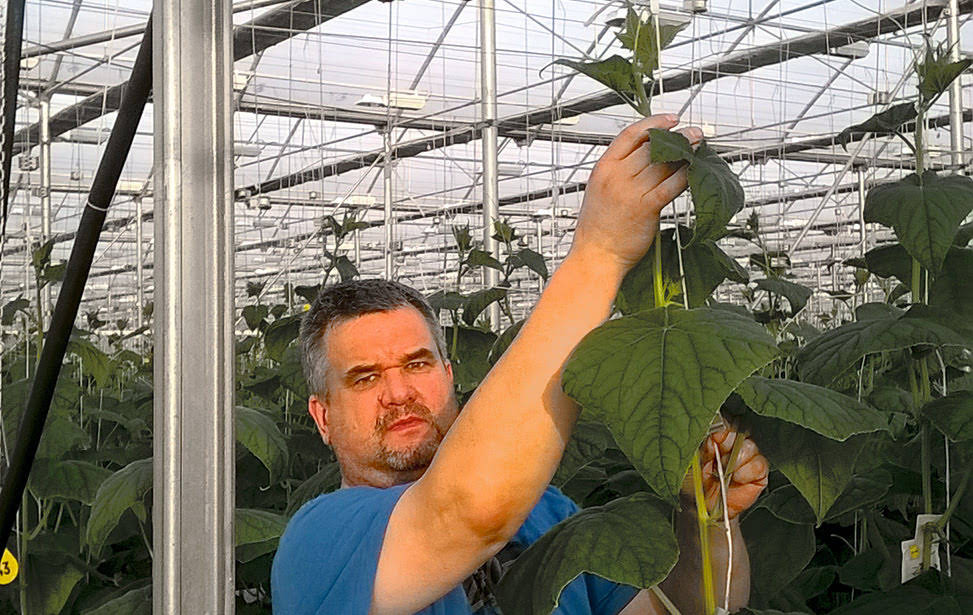- English

Dick de Jong, a proponent of the Qlipr plant clamping system for many years, is responsible for cucumber cultivation at FoodVentures in Georgia. Aside from helping entrepreneurs get started with Qlipr he also assists ‘Qlipr growers’ to get the most out of their crops. With the establishment of the new cucumber divisions at FoodVentures, De Jong once again opted for Qlipr. The experience has been positive. “Qlipr is easy, efficient and completely sustainable.”
Dick de Jong used to run his own cucumber farm in Dongen, the Netherlands, but after closing the business he started working as an independent horticultural consultant in 2007. De Jong has his own projects in Georgia and the Ukraine and he has been responsible for cucumber cultivation at FoodVentures in Georgia since 2014. Cucumbers are grown on an area of two hectares in this horticulture company, which was founded by Dutch investors with Georgian partners. “Initially we only grew cucumbers in a tunnel greenhouse of 5,000 m2, but another greenhouse of 16,000 m2 was built last year for cucumbers,” said De Jong. “We also grow lettuce on a surface of 4,000 m2.”
Simple and effective
De Jong had already used the Qlipr method in his own company and he continues to employ this technique at FoodVentures. “The biggest advantage with Qlipr is that lowering, pinching of side shoots and winding can all be done in one go. It is easy and efficient; you easily save anywhere between 10 to 15 percent on labour! Another plus is that the Qlipr plant clamping system is extremely sustainable.”
It therefore made perfect sense to De Jong to likewise install Qlipr within a large part of the new divisions that were taken into operation during the past twelve-month period.
According to the grower-consultant the Qlipr system has proven itself yet again in cucumber cultivation over the past year. “Above all, the system is very straightforward; people quickly learn how to use it. Compared to winding, the clamping method shows a reduction in terminal shoot breakage, the system is simple and effective, and working conditions are improved significantly. If you work with a tomato hook you are standing above the crop when you lower it, which is far from ideal, especially considering that temperatures can reach between 30 and 35 degrees during Georgian summers.”
De Jong is also convinced that Qlipr will be more cost-effective in the long term than a system using a tomato hook and plastic clips. “You only need two Qlipr crop clamps per plant, whereas you need many more plastic clips and always need to invest in more. Granted, the initial investment with Qlipr is higher, but it works out cheaper over time, and isn’t that what it’s all about in the long run?”
Advice and assistance
FoodVentures wants to play a leading role in the further development of the horticultural sector in the countries around the Black Sea, a region still in its infancy in terms of horticulture. For this reason Dick de Jong also provides advice and assistance to several new developments in this geographical area. “This is where we share our horticultural know-how and where we become involved with innovations in the areas of lighting and cultivation systems. Qlipr plays an equally important role here. It is not always straightforward to train unskilled employees in certain tasks at new production sites, but the Qlipr system is helping to keep things relatively simple. This saves you time and, as already stated, working conditions are significantly improved. This means that new ventures can get off to a flying start.”
Testing with tomatoes
FoodVentures is eager to become involved with the cultivation of other products in future including peppers, eggplants and tomatoes, in order to further reinforce its position as an innovative player. “Our aim is to produce more goods for the local market. I also see opportunities for Qlipr in tomato cultivation, which we intend to test. We are similarly looking into growing less common varieties of cucumber, as well as using a combination of LED lighting and SON-T light for cultivation. All this with the aim of putting our business on the map and unlocking Dutch horticultural expertise for this region.”